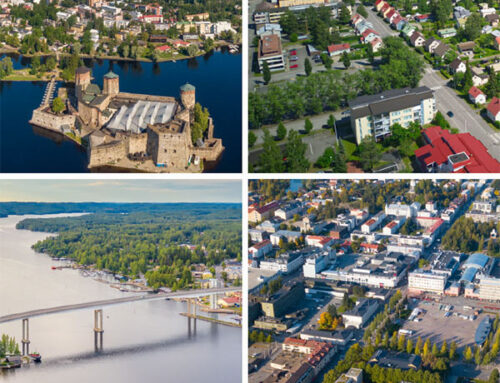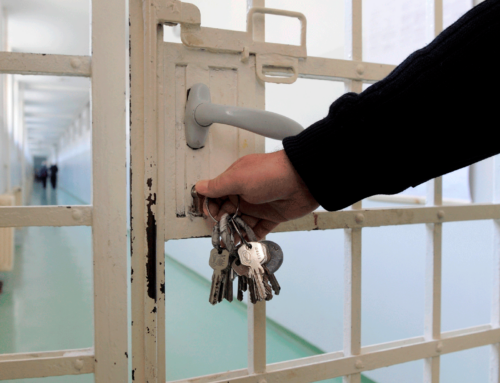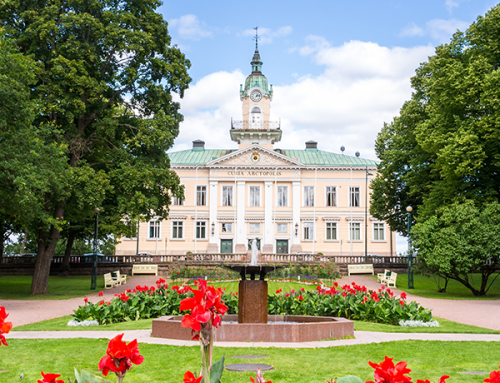Hundreds of rescue personnel, dozens of rescue vehicles, countless working hours. On Monday 26 July, Jokilaaksot Rescue Service Department, operating in the southern part of Northern Ostrobothnia within 17 municipalities, was alerted to a wildfire in Kalajoki, Finland. The operation, at the height of the holiday season, became a massive firefighting mission. It showed what a united front of Finnish authorities, volunteers and local residents can achieve together when a natural disaster strikes.
Harri Huumo knows the Jokilaaksot Rescue Service Department like the back of his hand. With twenty years of service at the department, he is both a seasoned fireman and fire officer. At the moment, Huumo works as a Chief Information Security Officer and was on the front line in Kalajoki as well.
“During the Kalajoki wildfire, I was in charge of operations at the scene. We established a control centre literally in the middle of nowhere, in the woods. That alone was quite a job,” says Huumo.
“The full extent of the situation became clear to us pretty quickly. We had all the equipment and personnel that were available in the region. One challenge with reaching people and coordinating the operation was that it was the height of the holiday season. In total, we had at least 15 other Finnish rescue services helping us, plus the Finnish Defence Forces, Finnish Border Guard, Aslak rescue helicopter and local private persons. A total of some 1,500 people were involved. A big thank-you to everyone,” says Huumo.
230 hectares on fire – no 9 to 5 job
Fortunately, there are rather few major wildfires in Finland, although the most recent similar example occurred last year, with almost the same size of forest on fire in Muhos, in an area about the size of central Helsinki. What was exceptional about the Kalajoki wildfire was that it spread quickly and extended to the tops of the trees, making it difficult to extinguish.
Wildfires often occur in places where the terrain makes moving difficult. In addition, they tend to last long. In Kalajoki, the firefighting took more than a fortnight.
“It was really hard work, it can’t be denied. We know from experience that we could be looking at days, even weeks of effort. What made the situation even more difficult for us was that shifts had to run without interruption around the clock for a very extended period. 24 hours is a long time to work for anyone, even without the added difficulty of a hot summer and difficult terrain, so it really was gruelling,” says Huumo.
“We soon established 12-hour shifts, informing the people involved so that they knew they would get some rest as soon as possible. This was important both in terms of safety and coping. In a way, we were running our own employment and HR office in the forest,” he adds with a little smile.
Huge need for personnel put the rescue services under pressure – “Fortunately we had Secapp”
Alerting personnel to join the operation started immediately. First the Jokilaaksot Rescue Service Department had to get in touch with their own staff, approximately 500 people.
“We obviously had a huge need to alert our people to the scene from the 23 fire stations in our region. Secapp was the only channel through which we reached them all fast, also getting replies whether they were able to participate or not. We also used Secapp to share information on how the operation was progressing. We did not have any other system that would have worked as good and fast. Fortunately, we had Secapp,” says Huumo.
Jokilaaksot Rescue Service Department were also fortunate to have started using Secapp earlier this spring and were familiar with the system.
“Secapp is now being used in most of our fire stations, and the users have been happy with it. The software brings plenty of benefits, most importantly dispatching and two-way communication, helping us to create a situational awareness in real time. Due to ease of use and updating user information, we use the system all the time, and we have gained good skills to use it. That is a significant reason it was so useful in the Kalajoki case. There would not have been time to start learning new system in the forest in the middle of the operation,” says Huumo.
“We can warmly recommend Secapp for all organizations providing rescue services. I’m sure it would be useful also in similar unexpected situations requiring extensive cooperation in a national level. After all, it’s a modern system,” says Huumo.
Facts
Kalajoki wildfire in 2021
- The fire started in Rautio village in Kalajoki on 26 July, lasting over two weeks
- The burnt area was 227 hectares, about the size of central Helsinki
- Operation was led by Jokilaaksot Rescue Service Department
- 15 other fire departments assisted, including the Finnish Defence Forces, Finnish Border Guard, Aslak rescue helicopter and local private actors
- Up to 250 firefighters working per day
- A total of some 1,500 people took part in the firefighting during the entire operation
Jokilaaksot Rescue Service Department
- One of Finland’s 22 regional rescue service departments
- Operates from the southern part of Northern Ostrobothnia, within 17 municipalities
- The region has 23 fire stations
- About 260 full-time staff
- About 500 staff under contract
- Ensures safety around three rivers: Kalajoki, Pyhäjoki and Siikajoki.
- Website: jokipelastus.fi
Hundreds of rescue personnel, dozens of rescue vehicles, countless working hours. On Monday 26 July, Jokilaaksot Rescue Service Department, operating in the southern part of Northern Ostrobothnia within 17 municipalities, was alerted to a wildfire in Kalajoki, Finland. The operation, at the height of the holiday season, became a massive firefighting mission. It showed what a united front of Finnish authorities, volunteers and local residents can achieve together when a natural disaster strikes.
Harri Huumo knows the Jokilaaksot Rescue Service Department like the back of his hand. With twenty years of service at the department, he is both a seasoned fireman and fire officer. At the moment, Huumo works as a Chief Information Security Officer and was on the front line in Kalajoki as well.
“During the Kalajoki wildfire, I was in charge of operations at the scene. We established a control centre literally in the middle of nowhere, in the woods. That alone was quite a job,” says Huumo.
“The full extent of the situation became clear to us pretty quickly. We had all the equipment and personnel that were available in the region. One challenge with reaching people and coordinating the operation was that it was the height of the holiday season. In total, we had at least 15 other Finnish rescue services helping us, plus the Finnish Defence Forces, Finnish Border Guard, Aslak rescue helicopter and local private persons. A total of some 1,500 people were involved. A big thank-you to everyone,” says Huumo.
230 hectares on fire – no 9 to 5 job
Fortunately, there are rather few major wildfires in Finland, although the most recent similar example occurred last year, with almost the same size of forest on fire in Muhos, in an area about the size of central Helsinki. What was exceptional about the Kalajoki wildfire was that it spread quickly and extended to the tops of the trees, making it difficult to extinguish.
Wildfires often occur in places where the terrain makes moving difficult. In addition, they tend to last long. In Kalajoki, the firefighting took more than a fortnight.
“It was really hard work, it can’t be denied. We know from experience that we could be looking at days, even weeks of effort. What made the situation even more difficult for us was that shifts had to run without interruption around the clock for a very extended period. 24 hours is a long time to work for anyone, even without the added difficulty of a hot summer and difficult terrain, so it really was gruelling,” says Huumo.
“We soon established 12-hour shifts, informing the people involved so that they knew they would get some rest as soon as possible. This was important both in terms of safety and coping. In a way, we were running our own employment and HR office in the forest,” he adds with a little smile.
Huge need for personnel put the rescue services under pressure – “Fortunately we had Secapp”
Alerting personnel to join the operation started immediately. First the Jokilaaksot Rescue Service Department had to get in touch with their own staff, approximately 500 people.
“We obviously had a huge need to alert our people to the scene from the 23 fire stations in our region. Secapp was the only channel through which we reached them all fast, also getting replies whether they were able to participate or not. We also used Secapp to share information on how the operation was progressing. We did not have any other system that would have worked as good and fast. Fortunately, we had Secapp,” says Huumo.
Jokilaaksot Rescue Service Department were also fortunate to have started using Secapp earlier this spring and were familiar with the system.
“Secapp is now being used in most of our fire stations, and the users have been happy with it. The software brings plenty of benefits, most importantly dispatching and two-way communication, helping us to create a situational awareness in real time. Due to ease of use and updating user information, we use the system all the time, and we have gained good skills to use it. That is a significant reason it was so useful in the Kalajoki case. There would not have been time to start learning new system in the forest in the middle of the operation,” says Huumo.
“We can warmly recommend Secapp for all organizations providing rescue services. I’m sure it would be useful also in similar unexpected situations requiring extensive cooperation in a national level. After all, it’s a modern system,” says Huumo.
Facts
Kalajoki wildfire in 2021
- The fire started in Rautio village in Kalajoki on 26 July, lasting over two weeks
- The burnt area was 227 hectares, about the size of central Helsinki
- Operation was led by Jokilaaksot Rescue Service Department
- 15 other fire departments assisted, including the Finnish Defence Forces, Finnish Border Guard, Aslak rescue helicopter and local private actors
- Up to 250 firefighters working per day
- A total of some 1,500 people took part in the firefighting during the entire operation
Jokilaaksot Rescue Service Department
- One of Finland’s 22 regional rescue service departments
- Operates from the southern part of Northern Ostrobothnia, within 17 municipalities
- The region has 23 fire stations
- About 260 full-time staff
- About 500 staff under contract
- Ensures safety around three rivers: Kalajoki, Pyhäjoki and Siikajoki.
- Website: jokipelastus.fi






